Central Asia facts for kids
Central Asia is a large and important region in Asia. It's like the heart of the continent! The main countries in Central Asia are Kazakhstan, Kyrgyzstan, Uzbekistan, Turkmenistan, and Tajikistan. Most of these countries are home to Turkic groups. Some definitions also include parts of China and Mongolia. The United Nations also sees Afghanistan as part of Central Asia.
Contents
A Look Back: Central Asia's History
People have lived in Central Asia since very old times. This region was a major part of the famous Silk Road. The Silk Road was a network of trade routes that connected the East and West for centuries.
Ancient Empires and Conquerors
For a long time, much of Central Asia was part of the Persian Empire. Then, Alexander the Great captured it. After Alexander died, his general named Seleucus took control. But Seleucus slowly lost the land to the Parthians. The Parthians were also Persian people.
When the Parthians lost power, the Sassanids added Central Asia to their Persian empire. Around the 600s A.D., Arab armies arrived. They quickly captured the region and brought the faith of Islam with them.
Rise of New Dynasties
Later, an Iranian dynasty called the Samanids gained some independence under the Abbasid Caliphate of Baghdad. The Samanids controlled most of Central Asia and parts of Iran during the 10th century. During their rule, Central Asian cities like Bukhara and Samarkand became important centers of culture.
Turkic and Mongol Rule
However, Turkish armies from the area, known as the Seljuk Turks, took the region from the Samanids. At the same time, a powerful leader named Timur also captured Central Asia. After Timur's death, his dynasty, the Timurids, could not keep their empire together.
They lost it to the Mongols. When the Mongols captured cities, they sometimes burned them down. Later, some rulers created their own smaller empires under Mongol rule. These were called Khanates.
Modern History and Independence
During the 19th century, the Russian Empire conquered these lands. They became part of Russia. Many years later, in 1991, all the countries of Central Asia declared their independence from the Soviet Union. This was a big moment for the region.
How Central Asia Makes Money
The countries in Central Asia have different ways of making money. Uzbekistan is known for growing a lot of cotton. Kazakhstan is very rich because it has large amounts of oil, gas, and metals. It sells these valuable resources to countries in Europe and China.
Turkmenistan has also done well since gaining independence from the Soviet Union. However, it has been run by a dictatorship. This means one person or a small group has all the power. Besides Kazakhstan, most of Central Asia is still developing its economy.
Related pages
- Dagestan
- East Turkestan (Xinjiang, China)
- Kashmir (Northern Pakistan and India)
- Kazakhstan
- Kyrgyzstan
- Tajikistan (South-central Asia)
- Tatarstan
- Turkmenistan (South-central Asia)
- Uzbekistan
- Mongolia (and Inner Mongolia, China)
- Soviet Union
- Soviet Central Asia
Images for kids
-
Expanded definition of Central Asia. The five post-Soviet states are in dark green. Afghanistan, often added to Central Asia, is in green.
-
Iranian-speaking people around 170 BC.
-
Mausoleum of Khoja Ahmed Yasawi in Hazrat-e Turkestan, Kazakhstan.
-
Kazakh man on a horse with a golden eagle.
-
Uzbek children in Samarkand.
-
A Tartar bowing before the Qianlong Emperor of China (1757).
-
A political cartoon from the time of the Great Game (1878).
-
Islam Karimov (President of Uzbekistan) at the Pentagon, March 2002.
See also
 In Spanish: Asia Central para niños
In Spanish: Asia Central para niños


















